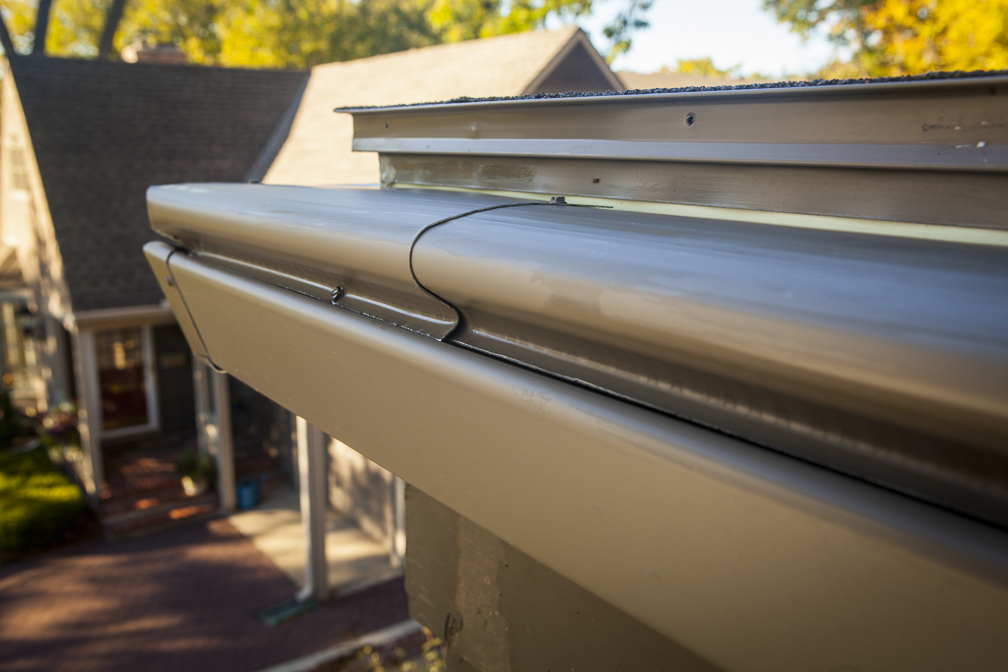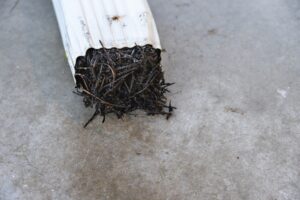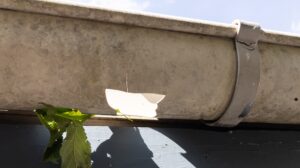
Traditional gutters have a long history, dating back to the Indus Valley civilization between 3000 BC and 1500 BC. However, for practical purposes, let’s fast forward to the 1940s when the modern-day traditional gutter, known as the K-Style gutter, was invented by Art Knudson. These gutters were usually made from steel and came in prefabricated sections of 8-10 feet, cut to fit the lengths needed for homes. You can still find these traditional gutter sections at home improvement stores like Home Depot and Lowe’s. While they are cost-effective upon initial purchase, they often lead to more costly problems over time.
The Problem with Traditional Gutters
Traditional gutters are held together by numerous seams, and for a gutter to function most effectively, a minimal number of seams is desirable. Over time, these seams inevitably leak unless new sealant is regularly applied. The individual sections of traditional gutters also struggle to maintain a consistent and gradual pitch over the length of an entire roof’s drip edge. This can lead to sagging at the seams or within the sections themselves, causing water to drip through the seams or fill up in the sagging sections, eventually overflowing as if they were clogged. The only solution to this problem would be to install a seamless gutter that spans the entire length of the roof’s drip edge.
The Evolution of Seamless Gutters
In the 1960s, Art Knudson invented the world’s first K-Style seamless gutter machine in Broomfield, Colorado. This invention revolutionized the modern gutter industry. With aluminum replacing steel as the material of choice, Art devised a way to roll a sheet of aluminum off a coil, through a bending machine, and produce a perfectly shaped, seamless run of K-Style gutter cut to any length, with widths spanning from 4” to 8”. This design is still the most common type of gutter on homes today.
The Limitations of K-Style Gutters
Although the modern K-Style seamless gutter is effective in evacuating rainwater and snowmelt, it still has its limitations. These gutters are mounted to your fascia wood with internal brackets and screws every 24 inches. The gutter’s design, with its front and back lips at the same height, can cause problems when debris like leaves or twigs enters the system. Once debris clogs the downspout, the entire gutter fills with water and overflows, damaging both your foundation and the wood behind the gutter.
The Invention of K-Guard Gutters
To solve these issues, Art Knudson’s son, Gary, invented the K-Guard gutter system in the 1990s. K-Guard is a seamless gutter system that incorporates a removable hood using reverse curve technology. This design efficiently collects rainwater and snowmelt while shedding debris to the ground, preventing clogs.
The Advantages of K-Guard Gutters
K-Guard gutters are designed with a higher back, which slides upward under the backside of your drip edge flashing. This design ensures that water can never overflow the back side of the gutter. Additionally, the angled hanger bracket, mounted with a screw and neoprene washer at a higher elevation than the front lip of the gutter, prevents water from wicking back into the wood, keeping your fascia dry and protected. These brackets can support up to 75 pounds and are mounted every 24 inches, allowing K-Guard to confidently offer a lifetime, double transferable “no pull away” warranty that includes back pitching.
K-Guard’s Unique Design Features
The angled hanger brackets not only support the gutter but also the separate curved hood. This two-piece system includes a relief channel on the back side of the hood, offering extra protection from water jumping behind the gutter during heavy winds. If debris ever causes a clog, the hood is removable, allowing the entire system to be flushed. However, K-Guard guarantees that this will never happen because any debris small enough to enter the system will flow out through the larger 3” x 4” downspout, which is twice the size of a traditional downspout.
Why K-Guard is Built to Last
Traditional gutters are usually made from 0.027” thickness aluminum, whereas K-Guard uses 0.032” thickness aluminum—the thickest aluminum that can be bent without cracking the paint. K-Guard offers a variety of colors with polymer-coated paint that’s baked on at the factory. This durable finish comes with a limited lifetime paint warranty against peeling, chipping, or cracking.
Comparing Warranties: K-Guard vs. Traditional Gutters
The major difference between traditional gutters and K-Guard, besides the fact that one was invented by the father and the other by the son, is the warranty. A standard traditional gutter typically comes with a two-year workmanship warranty and a lifetime guarantee that you or someone else will have to clean it out regularly to prevent damage. In contrast, K-Guard offers a lifetime “No Pull Away” warranty, a lifetime “No Clog” warranty, and a limited lifetime paint warranty. With K-Guard, you’ll never have to worry about your gutters again. Call us today to learn more about how K-Guard can protect your home.



